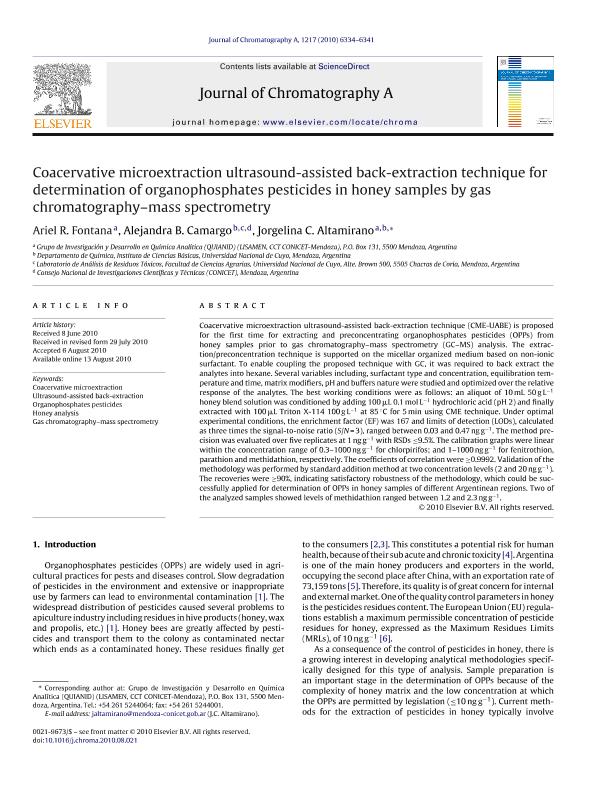Mostrar el registro sencillo del ítem
dc.contributor.author
Fontana, Ariel Ramón

dc.contributor.author
Camargo, Alejandra Beatriz

dc.contributor.author
Altamirano, Jorgelina Cecilia

dc.date.available
2020-06-04T16:01:47Z
dc.date.issued
2010-10
dc.identifier.citation
Fontana, Ariel Ramón; Camargo, Alejandra Beatriz; Altamirano, Jorgelina Cecilia; Coacervative microextraction ultrasound-assisted back-extraction technique for determination of organophosphates pesticides in honey samples by gas chromatography–mass spectrometry; Elsevier Science; Journal of Chromatography - A; 1217; 41; 10-2010; 6334-6341
dc.identifier.issn
0021-9673
dc.identifier.uri
http://hdl.handle.net/11336/106679
dc.description.abstract
Coacervative microextraction ultrasound-assisted back-extraction technique (CME-UABE)is proposed for the first time for extracting and preconcentrating organophosphates pesticides (OPPs) from honey samples prior to gas chromatography-mass spectrometry (GC-MS) analysis.The extraction/preconcentration technique is supported on the micellar organized medium based on non-ionic surfactant. To enable coupling the proposed technique with GC, it was required to back extract the analytes into hexane. Several variables including, surfactant type and concentration, equilibration temperature and time, matrix modifiers, pH and buffers nature were studied and optimized over the relative response of the analytes. The best working conditions were as follows: an aliquot of 10 mL 50 g L-1 honey blend solution was conditioned by adding 100 µL 0.1 mol L-1 hydrochloric acid (pH 2) and finally extracted with 100 µL Triton X-114 100 g L-1 at 85 °C for 5 min by using CME technique. Under optimal experimental conditions, the enrichment factor (EF) was 167 and limits of detection (LODs), calculated as three times the signal-to-noise ratio (S/N=3), ranged between 0.03 ng g-1 and 0.47 ng g-1. The method precision was evaluated over five replicates at 1 ng g-1 with RSDs lower than 9.5%.The calibration graphs were linear within the concentration range of 0.3-1000 ng g-1 for Chlorpirifos; and 1-1000 ng g-1 for Fenitrothion, Parathion and Methidathion; respectively. The coefficients of correlation were higher than 0.9992.Validation of the methodology was performed by standard addition method at two concentration levels (2 and 20 ng g-1). The recoveries were higher than 90%, indicating satisfactory robustness of the methodology, which could be successfully applied for determination of OPPs in honey samples of different Argentinean regions. Two of the analyzed samples showed levels of methidathion ranged between 1.2 to 2.3 ng g-1.
dc.format
application/pdf
dc.language.iso
eng
dc.publisher
Elsevier Science

dc.rights
info:eu-repo/semantics/openAccess
dc.rights.uri
https://creativecommons.org/licenses/by-nc-sa/2.5/ar/
dc.subject
COACERVATIVE MICROEXTRACTION
dc.subject
ULTRASOUND-ASSISTED BACK-EXTRACTION
dc.subject
ORGANOPHOSPHATES PESTICIDES
dc.subject
HONEY ANALYSIS
dc.subject
GAS CHROMATOGRAPHY-MASS SPECTROMETRY
dc.subject.classification
Química Analítica

dc.subject.classification
Ciencias Químicas

dc.subject.classification
CIENCIAS NATURALES Y EXACTAS

dc.title
Coacervative microextraction ultrasound-assisted back-extraction technique for determination of organophosphates pesticides in honey samples by gas chromatography–mass spectrometry
dc.type
info:eu-repo/semantics/article
dc.type
info:ar-repo/semantics/artículo
dc.type
info:eu-repo/semantics/publishedVersion
dc.date.updated
2020-05-11T16:46:54Z
dc.journal.volume
1217
dc.journal.number
41
dc.journal.pagination
6334-6341
dc.journal.pais
Países Bajos

dc.journal.ciudad
Amsterdam
dc.description.fil
Fil: Fontana, Ariel Ramón. Consejo Nacional de Investigaciones Científicas y Técnicas. Centro Regional de Investigaciones Científicas y Tecnológicas. Laboratorio de Investigaciones y Servicios Ambientales Mendoza; Argentina. Consejo Nacional de Investigaciones Científicas y Técnicas. Centro Científico Tecnológico Conicet - Mendoza. Instituto de Biología Agrícola de Mendoza. Universidad Nacional de Cuyo. Facultad de Ciencias Agrarias. Instituto de Biología Agrícola de Mendoza; Argentina
dc.description.fil
Fil: Camargo, Alejandra Beatriz. Universidad Nacional de Cuyo. Facultad de Ciencias Agrarias. Departamento de Ciencias Enológicas y Agroalimentarias. Laboratorio de Residuos Tóxicos; Argentina. Consejo Nacional de Investigaciones Científicas y Técnicas. Centro Científico Tecnológico Conicet - Mendoza. Instituto de Biología Agrícola de Mendoza. Universidad Nacional de Cuyo. Facultad de Ciencias Agrarias. Instituto de Biología Agrícola de Mendoza; Argentina
dc.description.fil
Fil: Altamirano, Jorgelina Cecilia. Consejo Nacional de Investigaciones Científicas y Técnicas. Centro Científico Tecnológico Conicet - Mendoza. Instituto Argentino de Nivología, Glaciología y Ciencias Ambientales. Provincia de Mendoza. Instituto Argentino de Nivología, Glaciología y Ciencias Ambientales. Universidad Nacional de Cuyo. Instituto Argentino de Nivología, Glaciología y Ciencias Ambientales; Argentina. Consejo Nacional de Investigaciones Científicas y Técnicas. Centro Regional de Investigaciones Científicas y Tecnológicas. Laboratorio de Investigaciones y Servicios Ambientales Mendoza; Argentina
dc.journal.title
Journal of Chromatography - A

dc.relation.alternativeid
info:eu-repo/semantics/altIdentifier/url/https://www.sciencedirect.com/science/article/abs/pii/S0021967310010733
dc.relation.alternativeid
info:eu-repo/semantics/altIdentifier/doi/http://dx.doi.org/10.1016/j.chroma.2010.08.021
Archivos asociados
